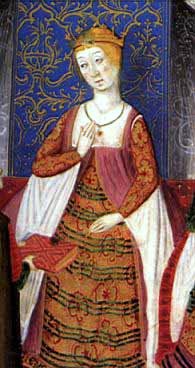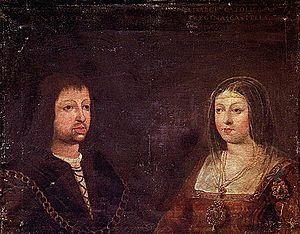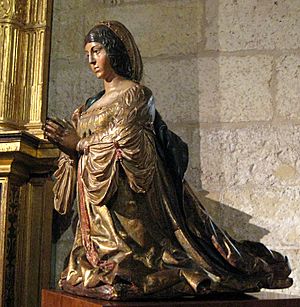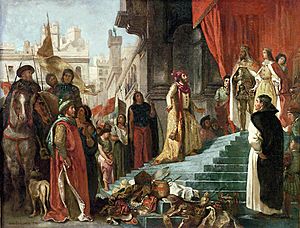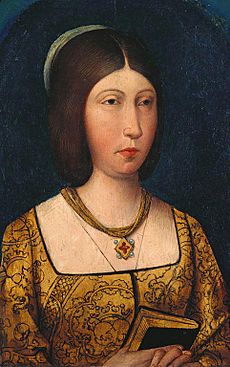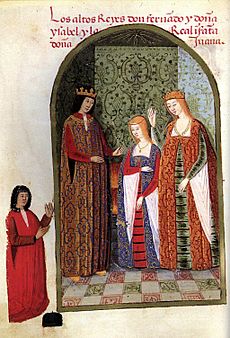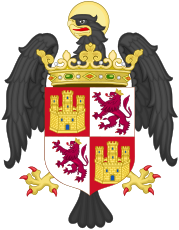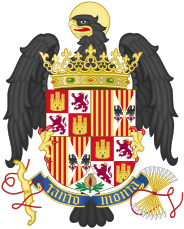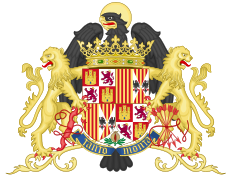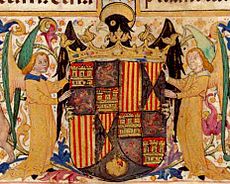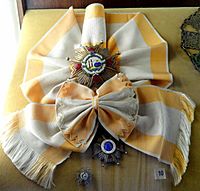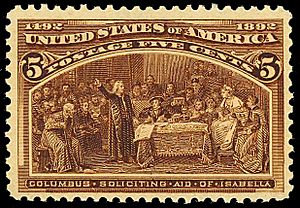Isabella I of Castile facts for kids
Quick facts for kids Isabella |
|
|---|---|

Portrait (c. 1490)
|
|
| Queen of Castile and León | |
| Reign | 11 December 1474 – 26 November 1504 |
| Coronation | 13 December 1474 |
| Predecessor | Henry IV |
| Successor | Joanna |
| Co-monarch | Ferdinand II |
| Queen consort of Aragon (more..) | |
| Tenure | 20 January 1479 – 26 November 1504 |
| Born | 1 April 1451 Madrigal de las Altas Torres |
| Died | 26 November 1504 (aged 53) Medina del Campo |
| Burial | Royal Chapel of Granada |
| Spouse | |
| Issue among others... |
|
| House | Trastámara |
| Father | John II of Castile |
| Mother | Isabella of Portugal |
| Religion | Roman Catholicism |
| Signature | |
Isabella I (born April 22, 1451 – died November 26, 1504) was a very important queen in Spanish history. She was also known as Isabella the Catholic. She ruled as Queen of Castile from 1474 until her death. She was also Queen consort of Aragon from 1479 because she was married to King Ferdinand II of Aragon.
Isabella and Ferdinand ruled together over a united Spain. They are often called the Catholic Monarchs. After becoming queen, Isabella worked hard to improve her kingdom. She fixed the government, lowered crime, and helped the kingdom get out of debt left by her half-brother, King Henry IV.
Her marriage to Ferdinand in 1469 was a key step in uniting Spain. Their changes had a big impact, not just in Spain but across Europe. Isabella and Ferdinand were the first rulers to be called "Queen of Spain" and "King of Spain." They are famous for finishing the Reconquista, which was a long war to take back Spain from Muslim rule. They also supported Christopher Columbus's 1492 voyage, which led to Europeans arriving in the New World. This helped create the Spanish Empire and made Spain a powerful country.
Isabella was given the title "Catholic Monarch" by Pope Alexander VI. In 1974, the Catholic Church recognized her as a Servant of God.
Contents
Life of Queen Isabella
Early Years and Challenges
Isabella was born in Madrigal de las Altas Torres on April 22, 1451. Her parents were John II of Castile and Isabella of Portugal. When she was born, she was second in line to the throne. Her older half-brother, Henry IV of Castile, was next in line.
Her younger brother, Alfonso, was born two years later. This made Isabella third in line. When her father died in 1454, Henry became King. Isabella and Alfonso were then cared for by King Henry. They moved with their mother to Arévalo.
Life in Arévalo was tough for Isabella. They lived in poor conditions and didn't have much money. Even though her father's will said his children should be well-off, King Henry didn't follow these wishes. Despite the difficulties, Isabella learned a lot about religion from her mother.
Later, Isabella and Alfonso were called to court in Segovia. King Henry wanted to supervise their education directly. Isabella joined the Queen's household.
Life improved for Isabella in Segovia. She always had food and clothes. She lived in a beautiful castle. Her education included reading, writing, history, math, art, and music. She enjoyed a relaxed life but rarely left Segovia. King Henry wanted to keep her away from the kingdom's political problems. However, Isabella knew exactly what was happening and her role in the conflicts.
Powerful nobles wanted more control. They demanded that King Henry name his younger half-brother Alfonso as his successor. They even asked Alfonso to take the throne. These nobles, now supporting Alfonso, fought King Henry's forces in the Second Battle of Olmedo in 1467. The battle ended without a clear winner.
King Henry then agreed to name Alfonso as his heir. He also said Alfonso should marry his daughter, Princess Joanna. But Alfonso died in July 1468, likely from a serious illness. The nobles who supported him suspected he was poisoned.
Alfonso's will named Isabella as his successor. So, the nobles asked Isabella to lead their rebellion. But support for the rebels was fading. Isabella preferred to find a peaceful solution instead of continuing the war. She met with King Henry at Toros de Guisando. They made a deal: the war would stop. King Henry would name Isabella as his heir, not his daughter Joanna. Isabella agreed not to marry without Henry's permission, but he couldn't force her to marry someone she didn't want. Isabella got most of what the nobles wanted. She also protected the idea of fair inheritance, which was important for her claim to the throne.
Isabella's Marriage Plans
Isabella's marriage had been a topic of discussion for a long time. When she was six, she was promised to Ferdinand. He was the younger son of John II of Navarre. This was meant to show friendship between King Henry and John. But this plan didn't last.
In 1458, Ferdinand's uncle, Alfonso V of Aragon, died. All of Alfonso's Spanish lands went to his brother, John II. John became very powerful and no longer needed Henry's friendship. Henry then looked for a new ally. He saw a chance with Charles, Prince of Viana, John's older son. Charles often argued with his father. He secretly made a deal with Henry IV of Castile. Part of this deal was a marriage between Charles and Isabella.
When John II found out, he was furious. He had planned for Isabella to marry his favorite younger son, Ferdinand. John II had Charles put in prison. Charles died in 1461.
In 1465, there was an attempt to marry Isabella to Afonso V of Portugal. He was King Henry's brother-in-law. Isabella, however, did not want this marriage and refused.
A civil war started in Castile because King Henry struggled to rule effectively. Henry needed a quick way to please the rebels. As part of a peace agreement, Isabella was to marry Pedro Girón Acuña Pacheco. He was a powerful knight and brother to the King's favorite, Juan Pacheco. In return, Don Pedro would pay a huge sum of money to the royal treasury. Henry agreed. Isabella was horrified and prayed the marriage would not happen. Her prayers were answered when Don Pedro suddenly died on his way to meet her.
When Henry recognized Isabella as his heir in 1468, he promised she wouldn't be forced to marry. In return, she agreed to get his consent. It seemed the years of forced political marriages were over. There was talk of marrying her to Edward IV of England or one of his brothers, but this never became serious.
Again in 1468, a marriage proposal came from Afonso V of Portugal. Henry went back on his promise and tried to make this marriage happen. If Isabella married Afonso, Henry's daughter Joanna would marry Afonso's son, John II. This way, John and Joanna could inherit both Portugal and Castile. Isabella refused. She secretly promised to marry her cousin and first betrothed, Ferdinand of Aragon.
After this failed attempt, Henry tried to marry Isabella to Louis XI's brother, Charles, Duke of Berry. Henry thought this would strengthen ties with France and keep Isabella out of Castilian politics. But Isabella refused again. Meanwhile, John II of Aragon secretly arranged for Isabella to marry his son Ferdinand.
On October 18, 1469, Isabella and Ferdinand officially became engaged. Because they were second cousins, their marriage needed special permission from the Pope to be legal. With help from a cardinal, Isabella and Ferdinand received a document that seemed to be from Pope Pius II (who had actually died in 1464), allowing them to marry.
Fearing opposition, Isabella secretly left Henry's court. She used the excuse of visiting her brother Alfonso's tomb. Ferdinand, disguised as a servant, also traveled secretly across Castile. They married immediately upon meeting on October 19, 1469, in Valladolid.
War for the Throne
On December 12, 1474, news reached Segovia that King Henry IV had died. Isabella quickly went to the Alcázar of Segovia. The next day, she was declared Queen of Castile and León.
Isabella's rule began with challenges. King Henry IV had named her as his successor. But some people, like Diego Pacheco, believed Henry's daughter, Joanna la Beltraneja, was the rightful queen. A supporter of Isabella, the Archbishop of Toledo, joined Pacheco. They planned for Joanna to marry her uncle, King Afonso V of Portugal. Then, they would invade Castile to claim the throne.
In May 1475, King Afonso and his army entered Spain. He married Joanna. A long and bloody war for the Castilian throne began. The war continued for almost a year. The Battle of Toro on March 1, 1476, was a key moment. Both sides claimed victory. King Afonso V's troops were defeated in one part of the battle, but John of Portugal's forces won another part.
Despite the unclear result, the Battle of Toro was a big political win for the Catholic Monarchs. It helped them secure the throne. Joanna's supporters scattered, and the Portuguese army, without allies, left Castile.
Isabella showed great leadership. She called a meeting of the Cortes (parliament) in 1476. There, her eldest daughter, Isabella, was named heir to Castile's crown. This helped make Isabella's own claim to the throne stronger.
In August 1476, Isabella proved her strength as a ruler. A rebellion started in Segovia while her husband Ferdinand was away fighting. Against her advisors' warnings, Isabella rode alone into the city. She successfully negotiated with the rebels, and the rebellion quickly ended. Two years later, Isabella's position as ruler became even stronger with the birth of her son, John, Prince of Asturias, on June 30, 1478. Many saw a male heir as proof that she was the rightful ruler.
Meanwhile, Castilian and Portuguese fleets fought for control of the Atlantic Ocean and the riches of Guinea (gold and slaves). The important naval Battle of Guinea took place during this time.
The war lasted three more years. It ended with Castile winning on land and Portugal winning at sea. The peace treaties signed at Alcáçovas (September 4, 1479) reflected this. Portugal gave up its claim to the Castilian throne in favor of Isabella. In return, Portugal gained control of many Atlantic territories, except for the Canary Islands. These included Guinea with its gold mines, Cape Verde, Madeira, and the Azores. Portugal also received a large payment.
The treaty meant Spain was mostly blocked from expanding in the Atlantic. This made people in Andalusia angry. However, Christopher Columbus's discovery of the New World changed everything. It led to a new agreement in 1494, the Treaty of Tordesillas, which divided the Atlantic more fairly. By supporting Columbus's journey west, Isabella and Ferdinand found a new path for expansion. They were very successful. Isabella had shown herself to be a strong and determined queen from the start. Now that she had secured her place on the throne, she could begin to make important changes for the kingdom.
Reforms and Improvements
A New Police Force
Isabella's first big change came in 1476. She created a police force called La Santa Hermandad (the Holy Brotherhood). While similar groups had existed before, this was the first time the crown used such a force to keep order. Before 1476, local nobles often controlled justice. Isabella wanted to change this.
The new Hermandad was made up of local people. They patrolled roads and punished criminals. It was paid for by a tax on households. In 1477, Isabella traveled to other parts of Spain to introduce this police force there too. This helped bring law and order back to the kingdom.
Fixing Finances
From the start, Isabella understood how important it was to fix the kingdom's money problems. King Henry IV's rule had left Castile deeply in debt. It was discovered that much of the problem came from Henry selling off royal lands for very low prices.
In 1480, the Cortes (parliament) decided that the best way to fix finances was to get these lands back. Many nobles agreed. Isabella was careful about taking such strong action. It was decided that an important church leader would investigate how lands were given away during Henry IV's reign. Lands not given as rewards were to be returned without payment. Lands sold too cheaply would be bought back at the original price. This made the royal treasury much richer. Isabella insisted that gifts made to churches, hospitals, or the poor would not be taken back.
Another money problem was too many mints making coins, and many of these coins were almost worthless. During Henry's reign, the number of mints had grown from five to 150. In her first year, Isabella took control of all royal mints. She set a standard for how good the coins had to be. By closing many mints and controlling coin production, Isabella made people trust the kingdom's money again.
Improving Government
Isabella and Ferdinand didn't create many new government offices. Instead, they made the existing ones work better. The center of the Castilian government was the royal household and court. This group had two main parts: household officials (mostly nobles) who did political jobs, and about 200 permanent servants who handled secret tasks.
By the 1470s, when Isabella took charge, the top jobs in the royal household were mostly honorary titles held by nobles. The more secretarial jobs were often held by church leaders. These positions came with good pay and were often passed down in noble families. While nobles held the titles, other people did the actual work.
The main advisory group to the rulers was the Royal Council. This council had the power to solve legal and political problems. It oversaw all top officials and was the highest court. In 1480, Isabella made many changes to the Royal Council. Before, there were two types of council members. One group had legal and administrative duties. It included bishops, nobles, and a growing number of trained lawyers called letrados. The second group had a less formal role, based on their influence with the monarch.
Isabella completely removed the second type of council member. She didn't care for personal favors. So, nobles were only allowed to attend the council as observers. Isabella started to rely more on professional administrators. These men often came from the middle class or lower nobility. The council was reorganized to include one bishop, three knights (caballeros), and eight or nine lawyers. Nobles could still attend meetings, but Isabella hoped this would show who was truly dedicated to the state.
Isabella also wanted to connect directly with her people. So, every Friday, Isabella and Ferdinand would sit and let people come to them with their complaints. This was a new way for people to get personal justice. The Council of State, which handled foreign affairs, was also reformed and led by the King and Queen. There was also a Supreme Court for the Santa Hermandad and a Council of Finance.
Even though Isabella made many reforms that seemed to strengthen the Cortes (parliament), its political power actually decreased. Isabella and Ferdinand moved towards a government where the Cortes had less say. It became more of an advisory body, often just approving laws already written by the royal administration.
After the reforms, Isabella asked a famous lawyer, Alfonso Diaz de Montalvo, to organize all the laws into a clear code. Within four years, this work was done in eight large books, called the Ordenanzas Reales.
Important Events of 1492
Conquering Granada
By 1492, only Granada remained to be conquered by Isabella and Ferdinand. The Emirate of Granada had been under Muslim rule for centuries. It was protected by mountains and strong towns. On February 1, 1482, the war for Granada began.
Isabella and Ferdinand were deeply involved in the war. Granada's leaders, however, were divided. This made it harder for them to fight back. Still, it took ten years to conquer Granada.
The Spanish monarchs gathered soldiers from many European countries. They also improved their artillery with the newest and best cannons. They slowly took over the kingdom, piece by piece. In 1485, they attacked Ronda, which surrendered quickly after heavy bombing. The next year, Loja was taken. One year later, Málaga fell. This meant the western part of the Muslim kingdom was now in Spanish hands. The eastern part fell after Baza in 1489.
The siege of Granada began in the spring of 1491. The last Muslim ruler, Muhammad XII, finally surrendered at the end of the year. On January 2, 1492, Isabella and Ferdinand entered Granada. They received the keys to the city. The main mosque was turned into a church. The Treaty of Granada was signed later that year. In it, Ferdinand and Isabella promised to let Muslims and Jews in Granada live in peace.
During the war, Isabella noticed the skills of Gonzalo Fernández de Córdoba. She made him a key negotiator. With her support, De Córdoba had an amazing military career. He changed how the Spanish army was organized and fought.
Columbus and New Lands
Just three months after entering Granada, Queen Isabella agreed to support Christopher Columbus. He wanted to find a new way to reach the East Indies by sailing west. The crown agreed to pay for his trip.
Columbus's expedition left on August 3, 1492. He arrived in the New World on October 12. He returned the next year and showed his findings to the monarchs. He brought back native people and gold. Spain then entered a "Golden Age" of exploration and colonization. This period led to the Spanish Empire.
In 1494, Isabella and Ferdinand signed the Treaty of Tordesillas with King John II of Portugal. They agreed to divide the world outside of Europe between them. The Portuguese did not agree that South America belonged to Spain. King John II threatened to send an army to claim the land.
Isabella's View on Slavery
Isabella did not support enslaving the American natives. She set a rule that indigenous people were subjects of the Crown of Castile. This meant they could not be enslaved in most cases. However, there were some situations where a person could be enslaved, such as being a prisoner of war.
Once, Columbus captured 1,200 men. Isabella ordered them to be returned and had Columbus arrested. Isabella realized she couldn't trust just one person with the exploration and spread of Christianity. So, she allowed other expeditions led by people like Alonso de Ojeda and Vicente Yáñez Pinzón.
To make sure her efforts continued after her death, Isabella wrote in her last will: "do not give rise to or allow the Indians [indigenous Americans] to receive any wrong in their persons and property, but rather that they be treated well and fairly, and if they have received any wrong, remedy it."
Expelling the Jews
With the Spanish Inquisition in Spain, led by Tomás de Torquemada, the Catholic Monarchs aimed for religious unity. On March 31, 1492, the Alhambra Decree was issued. This order told all Jews to leave Spain. They had four months to leave and could not take gold, silver, or money with them.
It was once believed that as many as 200,000 Jews left Spain. However, recent historians suggest that out of about 80,000 Jews, a maximum of 40,000 left. The rest converted to Christianity. Many who stayed were investigated by the Inquisition to see if they truly converted.
Later Years and Legacy
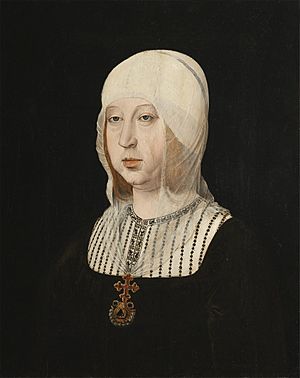
Isabella was given the title "Catholic Monarch" by Pope Alexander VI. Isabella and Ferdinand worked to unite Spain not just physically, but spiritually, under one faith (Roman Catholicism). The Inquisition became a strong part of this process. After a Muslim uprising in 1499, the Treaty of Granada was broken in 1502. Muslims were then ordered to either become Christians or leave Spain.
Isabella's advisor, Cisneros, became Archbishop of Toledo. He helped improve religious institutions in Spain. As Chancellor, he gained more and more power.
Isabella and Ferdinand had built an empire. In their later years, they focused on managing it and planning for the future. They wanted to connect the Spanish crown to other European rulers through marriages. By 1497, their plans seemed to be working. Their son and heir, John, Prince of Asturias, married a princess from the powerful Habsburg family. Their eldest daughter, Isabella of Aragon, married King Manuel I of Portugal. Their younger daughter, Joanna of Castile, married a Habsburg prince, Philip I of Habsburg. In 1500, Isabella declared that all non-rebellious native people in the colonies were citizens with full legal freedom.
However, Isabella's plans for her two eldest children did not work out. Her only son, John, died shortly after his marriage. Her daughter, Isabella of Aragon, died while giving birth to her son, Miguel da Paz, who also died young. So, Queen Isabella I's crowns passed to her third child, Joanna, and her son-in-law, Philip I.
Isabella did arrange successful marriages for her two youngest daughters. After Isabella of Aragon died, Manuel I of Portugal needed a new wife. Isabella's third daughter, Maria of Aragon, became his next bride. Isabella's youngest daughter, Catherine of Aragon, married England's Arthur, Prince of Wales. When he died young, she married his younger brother, King Henry VIII of England.
Isabella officially stepped back from government on September 14, 1504. She died that same year on November 26 at the Medina del Campo Royal Palace. She had been in declining health since the deaths of her son John in 1497, her mother in 1496, and her daughter Isabella in 1498.
She is buried in Granada in the Capilla Real. This chapel was built by her grandson, Charles V, Holy Roman Emperor (Carlos I of Spain). Her husband Ferdinand, her daughter Joanna, Joanna's husband Philip I, and her grandson Miguel da Paz are also buried there. The museum next to the chapel displays her crown and scepter.
Appearance and Personality
Isabella was short and strong. She had fair skin and hair that was between strawberry-blonde and auburn. Some descriptions say her hair was golden. Old paintings sometimes show her with dark brown hair, but this can happen to colors in old portraits. A statue of her in Granada Cathedral also shows her as a brunette. Her daughters, Joanna and Catherine, were said to look most like her.
Isabella lived a simple and disciplined life. Her strong religious beliefs guided her. Even though she was against Muslims in Andalusia, she liked Moorish art and style.
People who knew Isabella described her in different ways:
- Gonzalo Fernández de Oviedo y Valdés said: "To see her speak was divine."
- Andrés Bernáldez called her "an energetic woman, very powerful, very wise, very honest, pure, devoted, clever, truthful, clear, without deceit."
- Hernando del Pulgar noted: "She was very keen on justice, so much so that she was thought to follow strict rules rather than mercy. She did this to fix the many crimes she found in the kingdom when she became queen."
- Lucio Marineo Sículo told a story about a knight who offered a lot of money to avoid execution. The queen refused, saying justice was more important than money. She didn't take his wealth, giving it to his children instead.
- Ferdinand, in his will, said she was "a role model in all acts of virtue and fear of God."
- Her confessor, Francisco Jiménez de Cisneros, praised "her pure heart, her big heart and the greatness of her soul."
Family Life
Isabella and Ferdinand had seven children. Five of them lived to be adults:
- Isabella (1470–1498): She first married Afonso, Prince of Portugal but had no children. Then she married Manuel I of Portugal and had a son, Miguel da Paz, who died young.
- A son, born too early on May 31, 1475.
- John (1478–1497): He was the Prince of Asturias. He married Archduchess Margaret of Austria but had no surviving children.
- Joanna (1479–1555): She became Queen of Castile. She married Philip the Handsome and had children.
- Maria (1482–1517): She married Manuel I of Portugal, who was her sister's widower. She had children.
- A daughter, Maria's twin sister, born stillborn on July 1, 1482.
- Catherine (1485–1536): She first married Arthur, Prince of Wales, but had no children. Then she married his younger brother, Henry VIII of England. They had Henry, Duke of Cornwall and Mary I of England.
Becoming a Saint?
In 1958, the process to make Isabella a saint in the Catholic Church began. Experts looked at over 100,000 documents. In 1970, they decided that Isabella's actions were always guided by Christian beliefs. They also noted that she had a "reputation of sanctity" for five centuries.
In 1972, the official request for her sainthood was sent to the Congregation for the Causes of Saints in the Vatican. This was approved, and Isabella was given the title "Servant of God" in March 1974. The process was paused in 1991 because of her role in expelling the Jews. In 2020, Cardinal Cañizares confirmed that Pope Francis asked Spanish bishops to restart Isabella's sainthood cause.
Some historians believe Isabella's image as a saint was partly created by the queen herself.
Royal Symbols and Coats of Arms
As Princess of Asturias, Isabella used the royal symbols of Castile. She added the Saint John the Evangelist's Eagle as a single supporter. When she became queen, she combined the royal symbols of Castile with those of Aragon. She and Ferdinand also chose a yoke and a bundle of arrows as their special symbols.
As co-monarchs, Isabella and Ferdinand used the motto "Tanto Monta" (meaning "They amount to the same" or "Equal opposites in balance"). This referred to their agreement to rule equally. After conquering Granada in 1492, they added a pomegranate (Granada in Spanish) to their coat of arms to symbolize this victory. Sometimes, an older version of the Castilian royal symbols with two lions was used.
Isabella's Lasting Impact

Isabella is best remembered for helping Christopher Columbus's voyage to the New World. This journey brought great wealth to Spain and Europe. Her reign saw the start of the Spanish Empire, which eventually led to the creation of many modern countries in the Americas.
She and her husband completed the Reconquista. This ended a long period of Muslim rule in Western Europe. It also made Spain and the Iberian peninsula strongly Catholic. Her reign also established the Spanish Inquisition.
Honoring Isabella
In 1815, the Spanish crown created the Order of Isabella the Catholic to honor the queen.
Isabella was the first woman to appear on US postage stamps. She was featured on three stamps from the Columbian Issue in 1893, celebrating Columbus. She appears on the 5-cent stamp, the 15-cent stamp, and the $4 stamp, where she is shown with Columbus.
The $4 stamp is very rare and beautiful. It is highly valued by collectors.
Isabella was also the first named woman to appear on a United States coin. This was the 1893 Isabella quarter, a special coin celebrating 400 years since Columbus's first voyage.
Images for kids
See also
 In Spanish: Isabel I de Castilla para niños
In Spanish: Isabel I de Castilla para niños


